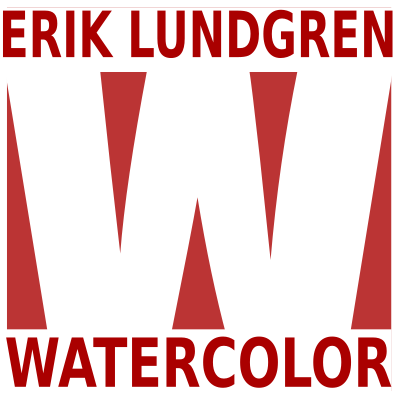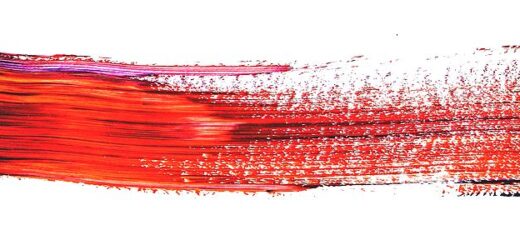Three triads

A combination of three colors, that forms an equilateral triangle on the color wheel, is usually called a color triad. These colors are thus all always the same distance from each other, but can otherwise vary. An example of such a color triad is the three primary colors yellow, red and blue. Another example could be orange, green and violet. Such theories are sometimes used in the design of color combinations for interiors, web pages, packaging and the like.
In this text I use the word triad to describe a three color palette for watercolor painting. Something I’ve also seen other artists do, so I guess it’s OK. These three colors should therefore not form a basis for creating color combinations, but they should form a basis for color mixtures.
Something I always do before I start painting is to decide which colors will be included in a painting. Unlike many other artists, I do not have a favorite palette that I always use. I choose new colors for each painting. Usually, there are three in number, and most often they are approximately the three primary colors, that is: a bluish color, a color towards the red side, and also a roughly yellow color.
In this text, I describe some of my most common three-color combinations, what type of motifs I use them for, and why. Various aspects influence the choice of colors and combinations of colors.
I often combine granulating colors with other granulating colors. Intense and vibrant colors go well together. Traditional colors, such as earth tones and mineral colors, make a good combination. Pale and weak colors are usually not good together with intense colors.
Triad 1 – Sunny and happy
This is based on the three primary colors. Translated to artist pigments, it is Phthalo Blue, Quinacridone Rose, and Lemon Yellow. This combination is great for summer or spring landscapes. In fact, it works well for any motif with clean, and perhaps cheerful colors. It is a triad I choose when pure color mixtures are needed.


Alternatives – triad 1
The blue color is always, in my case, Phthalo Blue Red Shade. It could also work with Phthalo Blue Green Shade or Prussian Blue, but these are colors I never use; for me, it is Phthalo Blue Red Shade that I use.
Since the lemon yellow color is so bland and boring, I often swap it out for something else. Most often, the warmer Nickel Azo is allowed to take its place, but it also works with other yellow or yellowish colors.
I sometimes replace the red color with some other intense synthetic color. It can be Perylene Maroon, pyrrole scarlet or another red color, the red color should be quite cold and powerful.
Triad 2 – Restrained and muted
One of my favorite combinations, which I keep coming back to, is French Ultramarine, burnt sienna and raw sienna. With these colors it is possible to create a soft and muted color scale in a painting.
The color scale in a painting made with these three colors varies between various unclear oranges and blues. No red or green colors can really be achieved with this triad, gray, brown and blue are characteristic of it. The blue color granulates heavily, the two siennas can be granulating or not, depending on which ones I choose. Different effects of granulation can be achieved, depending on whether the burnt or raw sienna granulates or not.


Alternatives – triad 2
A disadvantage of the colors is that it is not possible to mix green color with them. If green color is needed in a painting, I might replace the slightly dirty unburnt sienna with a cleaner yellow ochre, Rublev has a great one called “Lemmon Ochre”. If the subject calls for an even more pronounced green color, I have to use a lemon yellow, because the blue color is so red that all the other yellows turn grayish with it.
There are also alternatives to the reddish, granulating French Ultramarine: Cobalt Blue provides a softer and lighter color scale. The slightly warmer and slightly darker Deep Cobalt Blue is another option that works well.
The orange burnt sienna can be exchanged for any red or orange-brown color. I like to use Mummy Bauxite or Burnt Umber. Also red-brown colors like Venetian red or similar go well, and give a slightly violet tone to the painting, however I never use the modern dull and boring iron reds (PR101).
Triad 3 – Intense and strong
This triad consists of colorful, intense and unclear colors. The result with this triad will be contrasty and distinct. No pure colors can be mixed with these three, but that is not something you strive for if you choose such a combination of colors. The three colors are Indanthrone Blue, Perylene Maroon and Nickel Azo Yellow.


Alternatives – triad 3
The blue color is always Indanthrone while I use various yellows and reds. The most common red color I use is Perylene Maroon, but sometimes Quinacridone maroon, this when I need a more transparent result.
As for the yellow color, any orange-yellow color works. Ideally I use Nickel Azo which is both slightly unclear and transparent, it creates nice muted green colors together with Indantron. Isoindoline Yello is an almost orange color, which is also good in this context. Green Gold is another Nickel Azo pigment that I like to mix with. That color works great in combination with Indanthrone and Perylene Maroon.
Other triads
The triads above are the ones I use the most, but sometimes I make a different choice. Here are some examples of triads that I use less often:
- Phthalogreen (YS), Quinacridone rose and a yellow
- Any of the three triads above, but the blue replaced by a black.
- Secondary colors: A green, purple and orange.
It is of course possible to create a much larger variety of triads. The only thing you have to keep in mind when choosing three colors for a painting is that they must be able to mix together into a neutral color. This means that in a color circle, the triangle formed by the three colors must enclose the center, which is black. If the three colors do not, a neutral color cannot be created, and the triad is meaningless for representational painting.











